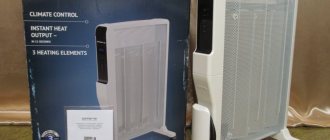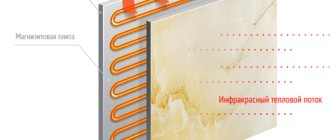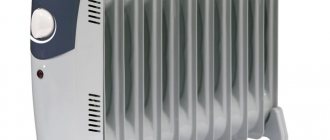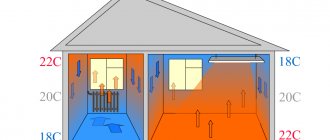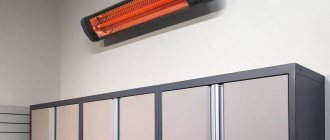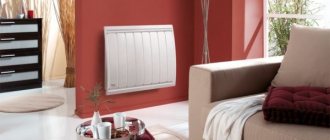The issue of alternative heating is relevant for residents of apartments, private houses and cottages. Heaters save the day in the cool off-season or become the main source of heating.
Among the variety of models, buyers are increasingly choosing quartz products.
What are their advantages, what are the features of their design and application?
We will answer these questions and also give practical advice on how to choose a quartz heater for domestic use.
Kinds
There are two types - infrared and quartz. The first are the simplest heating devices with a luminous glass tube that emits heat (sometimes there are two or even three tubes). They are divided into wall and floor, horizontal and vertical. The devices are intended for indoor use and cannot be used outdoors.
Quartz monolithic heaters heat by convection - they heat the air that circulates throughout the room, slowly warming up the entire volume. These devices are manufactured in the form of modules ready for installation and operation, so their installation and further use do not cause any special problems. The equipment can be called extremely unpretentious and extremely economical.
A quartz heater is a practical modern device for arranging alternative heating, which contains elements of quartz sand. It can serve as both main and auxiliary heating equipment.
To function correctly, it is connected to the electrical network and creates comfortable heat by passing current through a high-resistance element. Demonstrates an impressive level of efficiency and does not burn oxygen.
Let's sum it up
When choosing heating equipment on Yandex.Market, you can apply many filters to select the best option for you, and also see the lowest prices for the device you like.
The second question is where to stop? We recommend the following options:
- Ceiling or wall (ceramic) infrared heaters;
- Electric convectors;
- Quartz heaters.
If you don’t trust IR equipment, look at convectors or quartz heaters for your home.
They warm the air, but they do it longer than we would like. But if you are pressed for time, they will be an excellent option. If you have the opportunity to buy liquefied gas cylinders, you can use gas convectors - they will give your home warmth and will not lead to wild waste of money. Date: September 25, 2022
Classification of quartz aggregates
A quartz heater is a practical modern device for arranging alternative heating, which contains elements of quartz sand. It can serve as both main and auxiliary heating equipment.
To function correctly, it is connected to the electrical network and creates comfortable heat by passing current through a high-resistance element. Demonstrates an impressive level of efficiency and does not burn oxygen.
It works on a resistive principle and is considered the safest for users, since it does not generate a magnetic field and does not heat metal accessories on the clothes of a person who comes too close to the unit.
It uses electricity wisely and makes it possible to save on utility bills without compromising your own comfort.
Manufacturers of heating equipment today offer two types of quartz units: infrared and monolithic (MKTEN). Both devices cope excellently with their tasks and have their own positive qualities.
What else to pay attention to
If you are in doubt about choosing the right device, he recommends taking a holistic approach and asking a few important questions.
- Will the device be safe for children and pets?
- Does the heater require constant human supervision?
- How difficult is it to maintain the device?
- How many devices of this type should be purchased for a room that needs to be heated?
- Is it important that the appearance of the heating device matches the overall interior of the room?
Warmer House specialists will help you find answers to all your questions and provide any assistance when choosing a quartz heater for your home - they will recommend the most effective devices for individual rooms, and point out the individual advantages of certain models. In addition, it is possible to conduct an on-site comparative analysis of the main technical characteristics so that the ultimately selected quartz heater best meets the requirements of customers and fully meets expectations.
Types of IR devices
The heating element in quartz infrared heaters is a nichrome, tungsten or carbon spiral. In open devices, it is wound around a ceramic base, behind which a reflector is placed.
Units of this type intensively burn oxygen and have a high level of fire hazard. It is strictly not recommended to use them.
In closed-type modules, the working element is the same spiral, only enclosed in a sealed tube made of durable quartz glass. The air from there is completely pumped out and oxygen combustion does not occur. The device demonstrates high efficiency and easily copes with heating small rooms.
If the heater is located in a place accessible to people, children or pets, the radiator must be equipped with additional protection: a transparent partition or metal mesh. This avoids accidents and protects residents from burns.
Oil radiators
I call them “batteries on wheels.” Indeed, in appearance they are exactly like sectional radiators. But instead of water, they have mineral oil inside. Heat is generated by the hidden coil. The liquid filler gradually heats up, and then the body. Ultimately, the unit simply “radiates heat.”
For this reason, I do not recommend using an oil cooler for families with a small child who is already walking or crawling. Although small, there is still a possibility of a burn from the metal case.
Main advantages:
- Affordable price - the devices have already become classics.
- Accidental fire is excluded - the radiator can be left on when leaving home.
- Quiet in operation.
- Easy to move around the apartment thanks to the wheels.
- The presence of a temperature sensor and timer in some “advanced” models. Thanks to these functions, you can configure the device and it will turn on/off on its own.
For me personally, an oil radiator is not an ideal option for heating a city apartment. And that's why:
- It dries the air no less than the old spiral units.
- It should not be placed near a wall or near furniture, especially varnished furniture. This means that he will constantly “stick out” in the middle of the room. Agree, it’s not very convenient.
- The coil and oil heat up more slowly, therefore, there will be a high energy consumption.
- The device mixes cold air with hot air, which promotes drafts.
My conclusion: Oil heaters are suitable for continuous use in small spaces such as offices or small bedrooms. This device will not be able to heat the air precisely so that the heat remains for half a day.
Monolithic model: device and parameters
The quartz monolithic heater has a simple design and consists of the following elements:
- the main heating element is a spiral made of nichrome (an alloy of nickel and chromium, enriched with silicon, iron, aluminum and manganese), which has an impressive resistivity, an increased level of heat resistance, good ductility, durability and reliability;
- monolithic slab - a heavy (about 12 kg) rectangular fragment made of quartz sand.
When assembling the unit, the nichrome spiral is equipped with the appropriate connecting parts and fasteners, and then placed in a zigzag shape in a mold and filled with a liquid solution of quartz sand.
Then the workpiece is placed under a press, given the desired shape, thoroughly dried and subjected to intensive high-temperature treatment in an oven. The finished product has clear parameters of length and width (60*35 cm), and the thickness of the slab is 2.5-3 cm.
Technical parameters of monoliths
A standard monolithic heating device has a size of 61*34*2.5 cm and weighs about 10 kg. Heating begins immediately after plugging the cable into the outlet. After 20 minutes, the stove reaches maximum operating temperatures (about +90°C) and fills the room with comfortable warmth. The rated power of the unit is 0.5 kW.
To heat a 16-meter room with a normal ceiling height, one monolithic module is enough. The equipment comes with three brackets (two lower and one upper). With their help, you can quickly and securely mount the device on the wall and immediately begin to operate it in full mode.
Infrared heating
A feeling of warmth occurs in a person when his body is exposed to electromagnetic radiation by waves from the infrared region of the spectrum. Therefore, infrared radiation (IR radiation) is usually called thermal radiation, and the heat from it is called infrared heat.
Since time immemorial, man has learned to do without solar heat, using a variety of heating devices in his home. Water heating radiators, so familiar to us, create a home microclimate through convective and radiation heat exchange with the environment. Air masses with a higher temperature rush upward and accumulate there, introducing a certain temperature imbalance in the distribution of heat in the living space:
- under the ceiling the air temperature is 22º C;
- the lower part of the room (in which people are located) does not warm up above 18 degrees.
In the case of infrared heating, the thermal radiation of the CO ensures uniform distribution of heat throughout the room. In Fig. Below is a comparative picture of the distribution of the temperature field for convective heating using water heating batteries and the infrared heating method using ceiling-type CO.
Comparison of temperature fields for convective and infrared heating methods
By analogy with sunlight, heating a room with artificial infrared radiation occurs through heat exchange between furnishings and the surrounding air. The air itself is not heated by IR waves; it is transparent to them and allows the waves to pass through unhindered.
Only objects that are exposed to infrared waves heat up. It is their heat that heats the surrounding air. This property of IR radiation is used for local heating of individual areas in the living room using portable heat exchangers.
How to choose
Now we come to the most important question - how to choose and what to look for when buying heating equipment? There are no difficulties in this matter, you just need to decide under what conditions the equipment will be operated and how often it should work.
The selection process is simple:
- If you need to solve the problem of periodic shutdowns of central heating or lack of heat, you should choose from infrared models;
- If you need to create an autonomous heating system, you need to purchase a monolithic quartz heater.
Infrared models are presented with samples with the widest power range ranging from 800 W to 2-3 kW. If there is a lack of heat, it is enough to purchase the lowest-power model. In all other cases, it is best to purchase monolithic heaters - for 15-16 square meters. m. area will require one module with a power of 0.4-0.5 kW. When choosing an infrared device, focus on the standard formula - 1 kW of power per 10 sq. m. area .
Infrared heaters will be the optimal choice for heating country houses, but only if the residents appear there occasionally and do not live there on a permanent basis.
Quartz heater. Is it worth buying?
Quartz heaters are heaters using quartz sand, which are labeled as energy-saving or energy-efficient from year to year. In fact, they have collected all the most sacred things, especially for the age group: they heat like a Russian stove, soft heat, do not burn oxygen, energy consumption is like a light bulb, heats up quickly and gives off heat for a long time.
In short, a wood-free oven with magical energy efficiency. Let's understand them from the point of view of physics and common sense - how they heat, what their real potential is, what makes them energy efficient and where the substitution of concepts occurs.
What it consists of:
A quartz heater consists of three main elements:
- Frame – also known as the frame of the device;
- The heating element is a nichrome thread, as in the cheapest needle heating elements;
- A substance based on quartz sand, cement, water and other components.
The slab that this quartz heater is made of initially looks like clay in a soft state, then it dries and hardens. In order for it to start heating, electricity is supplied to the heating element, the nichrome thread heats up and transfers heat to this stove.
Quartz heater. Big, very hot and heavy.
How it heats:
What type of heating are we dealing with here – thermal radiation. We bring our palm to the heater - we feel the warmth. Our heating radiators warm in the same way, but in addition to thermal radiation, they also have convection. There is practically no convection here, and the heat emitted by it is concentrated only in the place where the heater is installed, without being properly distributed throughout the room. To feel warm with him, you need to be in close proximity to him.
During operation, the surface temperature will be at the level of 90-100ºC, and not just in one particular area, but in the entire area of the device. Let's try the situation for ourselves. So you bought it. It heats where it is installed, and you are half a meter or a meter away from it. A stone that is heated, albeit not red hot, but up to 100ºC, more than half a meter long and weighs 12-15 kg, is evenly hot everywhere, and also has a metal profile on the sides and no cold zones. And with the lack of a certificate of voluntary fire certification. To put it mildly, this doesn't look particularly safe.
The quartz heater is very heavy and fragile - the weight varies from 12-16 kg. You won't find cheap or free shipping.
This is not a stove that cools down, and you lean on it with pleasure. And it’s unlikely that in Russian folk tales, Ivan the Fool lay on one of these and, at the behest of a pike, the warmth in the house with these heaters does not knock. Unless it’s a closet of 5 m2, where you just need to warm up the room.
Energy consumption:
So, energy consumption. It is universally declared to be low, even akin to a light bulb. This means an old light bulb with an incandescent filament, and not some good and truly energy-efficient modern one. Yes, it is really very low here. Low not due to some magical efficiency, but due to the power that the heater has only good enough to put it on the floor and warm your feet. That is, the idea of buying it for an area of 10-15 m2 can be discarded.
Basic energy consumption information:
Any electric heater operates with 100% efficiency - as much electricity as it takes, it gives out. There is no other way. The only household appliance whose efficiency is above 100% under certain conditions is an air conditioner, whose take-out ratio can even reach 1 to 4, but it is not always applicable and not everywhere.
If we are talking about absolutely any quartz heater, then their so-called “energy saving” occurs solely due to the very low power of the heating element, which is not enough to warm the room.
Their average power is 400 watts. Is it a lot or a little? There is an average when choosing a heater - 1000 watts per 10 m2, this is provided that the room has good thermal insulation and when the wind does not blow from the cracks. 400 watts will be enough for 4-5 m2. That is, to warm a room of 15 m2 you need to install three or four such heaters.
The question arises, what to do if we want to somehow optimize energy consumption?
Really, the question is, how can we make this useless stove energy efficient?
For electric heaters, the only option for reducing energy consumption is to manage the energy efficiency of the device, providing a dosed load on the heating element in automatic mode.
There is, for example, a convector with inverter control. The efficiency is the same - 1 to 1. Savings are achieved only due to the fact that the inverter control unit analyzes changes in air temperature over time (what it was, what it was, how much heat it released and how much it changed the temperature, what are the approximate losses) and based on This selects the optimal power of the convector at the required period to achieve the air temperature set by the person.
Electrolux Rapid and Ballu Apollo are inverter-controlled convectors.
In laboratory conditions, the energy efficiency of this method of controlling an electric heater has demonstrated very high indicators - optimization of energy consumption by even 70%. In practice, a convector consumes less by about 20-30% compared to a conventional heater.
We have a large layer of materials on inverter convectors, which can be found on our website and on our YouTube channel.
Technical points:
Heating time – 20 minutes. It is too long. A third of an hour will pass before he starts giving anything away. Modern good heaters, which are also comparable in price, reach operating temperature in a little more than a minute. But not over 20.
Most of these heaters come without a plug. Just an empty three-core wire, which is positioned as “convenient for connecting to a central heating system and outputting to a separate machine.” That is, I just bought it and connected it - no.
By default, the quartz heater is not even supplied with a plug; it must be purchased separately.
Lack of thermostat. A thermostat is a device that allows you to somehow regulate the operation of the device so that it does not overheat the room. Yes, of course, with 400 watts this is unlikely to be possible, but the presence of a thermostat even in the cheapest heaters has always been an integral part.
No supports or wheelbase. It weighs 12-15 kg. It's very hard. Carry it with your hands?
If we want to make the heater convenient to use and logically complete it by purchasing some additional elements:
- Heater – 4,000 rub.
- Fork – 250 rub.
- The thermostat is the cheapest - 1,000 rubles
- Stand with wheels – 800 rub.
- Possibility to control remotely via Wi-Fi – 1,000 rubles
- Possibility to control remotely via GSM – 5,000 rubles
Minimum program without remote control – 6,000 rubles Maximum program – from 7 to 12,000 thousand rubles
Although other useless additional elements can be screwed here, such as a reflector to the back of the device, external thermostats, protective screens, etc., which will compare its price with the most expensive offers on the market, where the heater is made of glass and stuffed with the latest technology, but it heats normally and has a normal warranty.
Results:
A quartz heater is a supposedly energy-saving heater with negligible heat output. I would like to hope that after such an analysis we will at least protect someone from purchasing it. Comparison with the Russian stove? Seriously? How many kW does it give off by burning a bunch of wood, and how much is some pathetic metal cord that gives off heat to this stove? How much heat transfer is there, how much is here. There is objectively not a single plus in favor of purchasing it. In short, an overly romanticized image.
